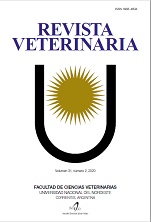Interruption of connection of the encephalic-truncus bridge with solutions of low cost like method for euthanasia of rodents
DOI:
https://doi.org/10.30972/vet.3124746Keywords:
rodents, cranio-encephalic traumatism, lidocaine, neurological interruptionAbstract
It is known that the brainstem bridge is the connector between the brain and the body, due to this a traumatic brain injury near the second portion of the brain could cause the interruption of neurological connections causing alternating or crossed hemiplegia, paralysis, insensitivity, so which, when determining this interruption in communication, the vital organs are compromised in their physiological function, causing the patient to suffer respiratory cardioarrest and death immediately. In the research study, bioterium animals were manipulated, in this case, they were mice of the Mus musculus species, the study comprised three groups; the first group was the application of lidocaine; the second group of distilled water and the third group was a control group where a simple puncture was performed with out the administration of any compound. Before the procedure, groups 1 and 2 were placed in the sevoflurane chamber for sedation and subsequent weighing, the occipital condyles were manually palpated with the ring finger and index finger with the non-dominant hand so that the application of the substance is done with the dominant hand and corroborate that it was being applied in the correct area. In the study, those of the first group suffered a neurological interruption that caused them to have a cardio-respiratory arrest between three to five minutes after application, in the second group the same thing happened, but between the next five to ten minutes; and in the third group they did not suffer immediate obvious sequelae.Downloads
References
Champney T. 2017. Neuroanatomía clínica esencial, 1º ed., Edit. Panamericana, México, 311 p.
Cuesta G.F. 2003. Patología veterinaria, 1º ed., Edit. Universidad de Antioquia, Medellín, 622 p.
Feliu P, Luján A. 2007. Trauma craneal. On line: https://ddd.uab.cat/pub/clivetpe- qani/11307064v27n3/11307064
v27n3p197.pdf.
Fernández VL, Bernardini M. 2007. Neurología del perro y el gato, Ed. Intermédica, Buenos Aires, 432 p.
García A, García L. 2016. Ética de la experimentación con animales. Bioética y Ciencias de la Salud. Vol. 3, N° 4, págs. 1-11.
González EM. 2014. Traumatismo craneoencefálico y hemofiltración venovenosa continua. Modelo experimental en conejos. On line: https://dialnet.unirioja.es/ser vlet/tesis?codigo=71509.
Gutiérrez AC. 2016. Biomodelos. Universidad Autónoma del Estado de México. http://ri.uaemex.mx/bitstream/handle/20.500.11799/64140/secme3126.pdf;jsessionid=FC3DC3F877719F33EB1321EBA3322FF0?sequence=1.
Haines D.E. 2014. Neuroanatomía clínica (Texto y Atlas), 9º ed., Wolters Kluwer Ed., Barcelona, 346 p.
Maurice V, Ropper AH. 2002. Principios de neurología, 6º ed., McGraw Hill – Interamericana, México, 1577 p.
Snell RS. 2010. Neuroanatomía clínica. Editorial Wolters Kluwer, Barcelona, 7º ed., 542 p.
Downloads
Published
How to Cite
Issue
Section
License
Revista Veterinaria (Rev. Vet.) maintains a commitment to the policies of Open Access to scientific information, as it considers that both scientific publications as well as research investigations funded by public resources should circulate freely without restrictions. Revista Veterinaria (Rev. Vet.) ratifies the Open Access model in which scientific publications are made freely available at no cost online.











.jpg)
.jpg)



